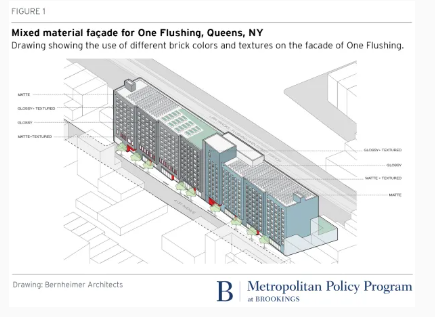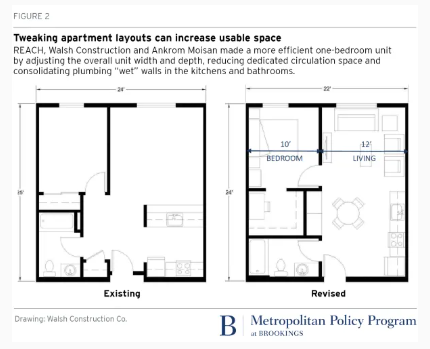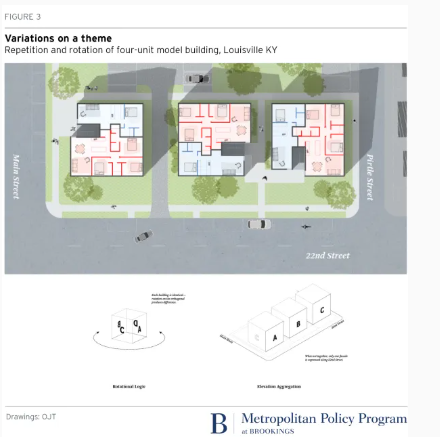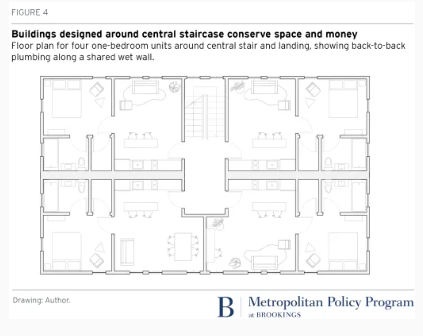One reason (pretext?) why people often oppose affordable housing in their nhood: they expect it to look ugly. Like Robert Taylor Homes. To which I say, ok boomer. My 4th & final piece w/ @hchoyt explains how good design is within reach for affordable hsg. https://www.brookings.edu/research/affordable-housing-doesnt-have-to-look-cheap-inside-or-out/">https://www.brookings.edu/research/...
Visually appealing, environmentally friendly apartments need a good facade. Not plain brick & concrete boxes, obv. Variation in materials, color, & texture add interest, and don& #39;t have to cost a fortune. For instance:
How about hot new(ish) trends like modular construction and alternative timber products? Won& #39;t they bring down construction costs & improve environmental performance? Maybe someday. But affordable developers haven& #39;t worked out all the kinks yet (like transport costs for modular).
Tweaks to apartment layout & floorplan can also improve efficiency, fitting more units per building at lower cost. Cut out hallways (not super useful space), align kitchens & baths along "wet" walls, & voila! (Think Yotel-style layouts--all the essentials but no wasted space.)
Another tweak: design a couple standard floorplans, then rotate & repeat to add variation w/out extra cost. (Not gonna lie, I love all of Hannah& #39;s graphics for this piece.)
People obsess over finishes in "luxury" buildings (granite countertops, stainless appliances), but the big costs are structural & required by building code: mechanical, electrical, plumbing systems. Plus elevators. Developers can& #39;t cut corners on these big items.
Elevators are obviously important for accessibility. But clever design can create small multifamily bldgs w/ accessible ground-floor units & no elevators--potentially important cost savings for small, infill sites.
How about green design? When affordable apartments are built w/ environmentally friendly building envelopes (think high-performance windows & doors), HVAC & plumbing systems, that can lower operating costs + have health benefits for residents. There& #39;s a learning curve, though.
Hannah& #39;s interviews uncovered some lessons for project teams (developers, architects, contractors). Close coordination among team members, upfront research on potential snags, & focusing on ways to shorten development process are all important. But there& #39;s a big caveat...
Even best project teams have limited control over construction costs b/c they have to operate within a fixed policy environment. Zoning laws & building codes set ground rules for development--complicated or excessively strict policies make apartment construction more costly.
One important policy reform to reduce apartment costs: reduce parking requirements! Especially near transit. https://www.brookings.edu/research/parking-requirements-and-foundations-are-driving-up-the-cost-of-multifamily-housing/">https://www.brookings.edu/research/...
2nd, zoning rules on density should be flexible, so developers can fit an economically efficient number of units on a site. (Be wary of inflexible building height limits, maximum FAR, setbacks, max units/acre...) https://www.brookings.edu/research/making-apartments-more-affordable-starts-with-understanding-the-costs-of-building-them/">https://www.brookings.edu/research/...
3rd, make the development review process shorter, simpler, and more transparent. Time is money. Allow apartments by right. Don& #39;t require endless community meetings that empower NIMBYs. Just don& #39;t. https://www.brookings.edu/research/flexible-zoning-and-streamlined-procedures-can-make-housing-more-affordable/">https://www.brookings.edu/research/...
US has chosen to make building "affordable" (eg subsidized) apartments complicated, slow, & expensive. Federal, state, & local policy choices all play a role. So if we want low-income families to have decent quality, safe, healthy housing, we need better policies. Now.
B/c this is our last installment, a couple shout-outs. These pieces are based on Hannah& #39;s report for @Harvard_JCHS funded by @neighborworks. (Thanks, guys!) All original ideas, insights, & awesome graphics are Hannah. Follow her, she& #39;s wicked smart! @hchoyt
Collaborating w/ Hannah has been a terrific learning process for me. I know lots about housing policy, but not much about architecture, design, or construction. Coauthoring w/ people in other disciplines, professions, or fields is GOOD. (Subtweeting economists here, yes.)
Coauthoring with students is VERY GOOD. Those of us who& #39;ve been around a while can definitely benefit from fresh eyes & ideas. Anything we oldsters can do to encourage bright, creative people to join our field, feel welcomed & supported, we should do. (Subtweeting many fields.)
Finally, scholars are (rightly) grappling w/ motivation for long-term research while world falls apart. This project isn& #39;t directly related to COVID or recession. But how to build safe, healthy, affordable hsg for low-income people still matters, so is still worth studying.

 Read on Twitter
Read on Twitter





